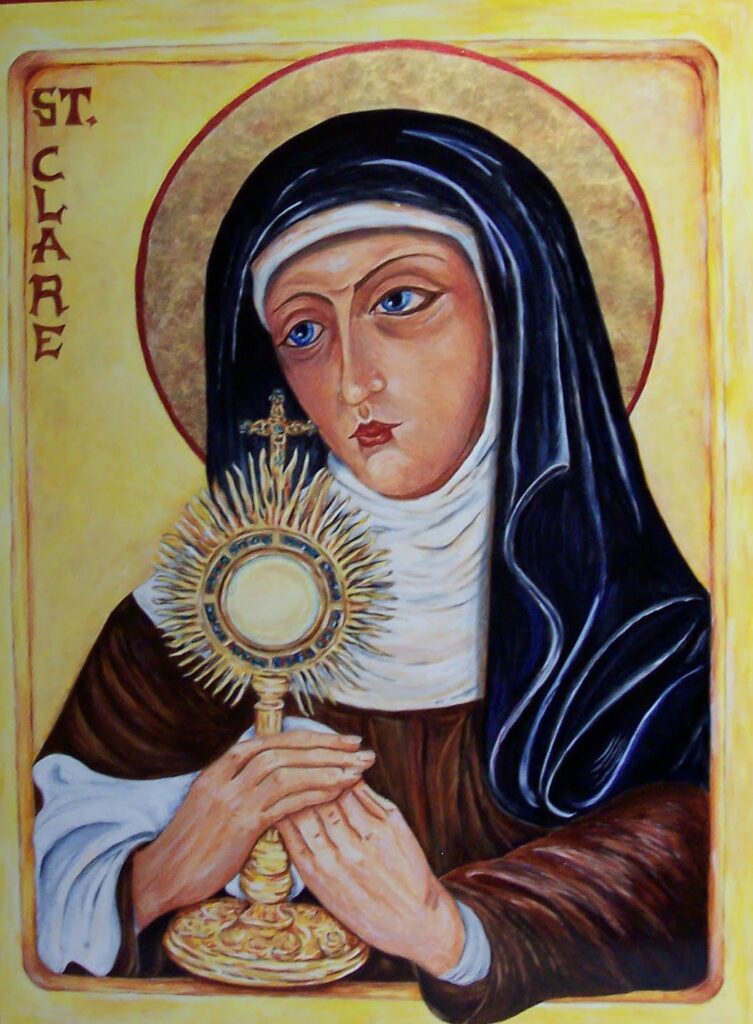
AUGUST 11 is the feast day of ST. CLARE (+1253). In 1969, it was moved from August 12.
Clare’s is a surprising story of fortitude and commitment. Clare was born in Assisi 16 July, 1194, daughter of Favorino Sciffi, the wealthy count of Sasso-Rosso, and his wife Ortolano, of the Fiumi family. The mother was a very devout woman who, during her lifetime, would go on several extreme pilgrimages. Clare had at least two sisters, Beatrix and Catarina. Needless to say, the sisters had the best of everything.
As a child, Clare both prayed and cared for the poor by taking food from her father’s table and putting it out for the hungry.
By Italian tradition, it is assumed that Clare was in line to marry. At 17, Clare heard Francis preach at the church of San Giorgio during a Lenten service. Apparently, she sought him out, after, and asked him to help her live after the manner of the Gospel. On the evening of Palm Sunday, 20 March 1212, Clare left her father’s home with her aunt, Bianca, and another companion. They met Francis at Potiuncula, the little monastery he had developed. Here, Francis cut off Clare’s hair and gave her a rough robe and veil to replace her rich clothes. He then placed her in the convent of Benedictine nuns near Bastia, to imply that she was now a religious. Her father and uncles came to “rescue” her but Clare adamantly clung to the altar and threw off her veil to show her shorn tresses, an implication of having taken the religious life. It is said that she declared she would have no other husband than Jesus Christ.
Within days, Francis sent her to the Benedictine monastery at Panzo, two km from Assisi. Within two weeks, Clare’s sister, Catarina, joined her. There they stayed while a small convent was built for them at San Damiano.
After leaving the Benedictines, Clare and a few followers followed the stricter rule established by the new Franciscan order. This included a life of complete poverty and austerity (even the community could own nothing). The sisters lived in seclusion, going out to serve the sick or beg for food. Their lives were ones of manual labor and prayer. They lived under the name of “Poor Ladies of San Damiano”.
Within four years, Clare became abbess of the “Second Order”. This meant that she made the rules, not just reinforce the rules of Francis. Clare was adamant to retain the commitment to corporate poverty. This was not just a one-time decision. She was constantly plied by prelates who tried to impose the rule of St. Benedict on her order. She resisted and imitated Francis’ virtues and way of life. It wasn’t until 2 days before her death that Pope Innocent IV confirmed Clare’s rule as the governing rule for the order.
After Francis’ death, Clare promoted her order, writing to abbeys all over Europe and thwarting papal requests to change. Her commitment to joyous poverty in imitation of Christ was her foremost goal.
Among the miracles credited to Clare were the defense of attacks on Assisi in 1240 and 1241 in which the Blessed Sacrament was exposed to the armies.
Well aware of Clare’s sanctity, the canonization process began immediately after her death. Pope Alexander IV had her canonized 26 September 1255. Within 10 years of her death, the order’s name was changed to the “Poor Clares”, in honor of the foundress.
“Go forth in peace, for you have followed the good road. Go forth without fear, for He that created you has sanctified you, has always protected you, and loves you as a mother. Blessed be thou, O God, for having created me.” St. Clare’s last words


Recent Comments